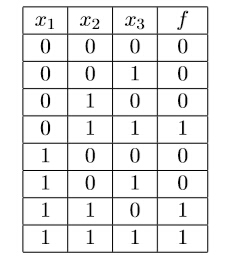Xiaoqiang entered the “shortest code” challenge organized by some self-claimed astrologists. He was given a boolean function taking n inputs (in C++):
bool f(bool x1, bool x2, bool x3){
//your code goes here
//return something
}
All possible inputs and expected outputs of this function have been revealed:

Xiaoqiang’s code must be like:
bool a = NAND(b, c);
where “a” is a newly defined variable,“b” and “c” can be a constant (0/1) or a function parameter (x1/x2/x3) or a previously defined variable. NAND is the “not-and” function:
NAND(b, c)=!(b&&c)
Because NAND is universal, Xiaoqiang knew that he could implement any boolean function he liked. Also, at the end of the code there should be a return statement:
return y;
where y can be a constant or a function parameter or a previously defined variable. After staring at the function for a while, Xiaoqiang came up with the answer:
bool a = NAND(x1, x2);
bool b = NAND(x2, x3);
bool y = NAND(a, b); return y;
Xiaoqiang wants to make sure that his solution is the shortest possible. Can you help him?
The first line contains an integer T (T ≤ 20) denoting the number of the test cases.
For each test case, there is one line containing 8 characters encoding the truth table of the function.
For each test case, output a single line containing the minimum number of lines Xiaoqiang has to write.

